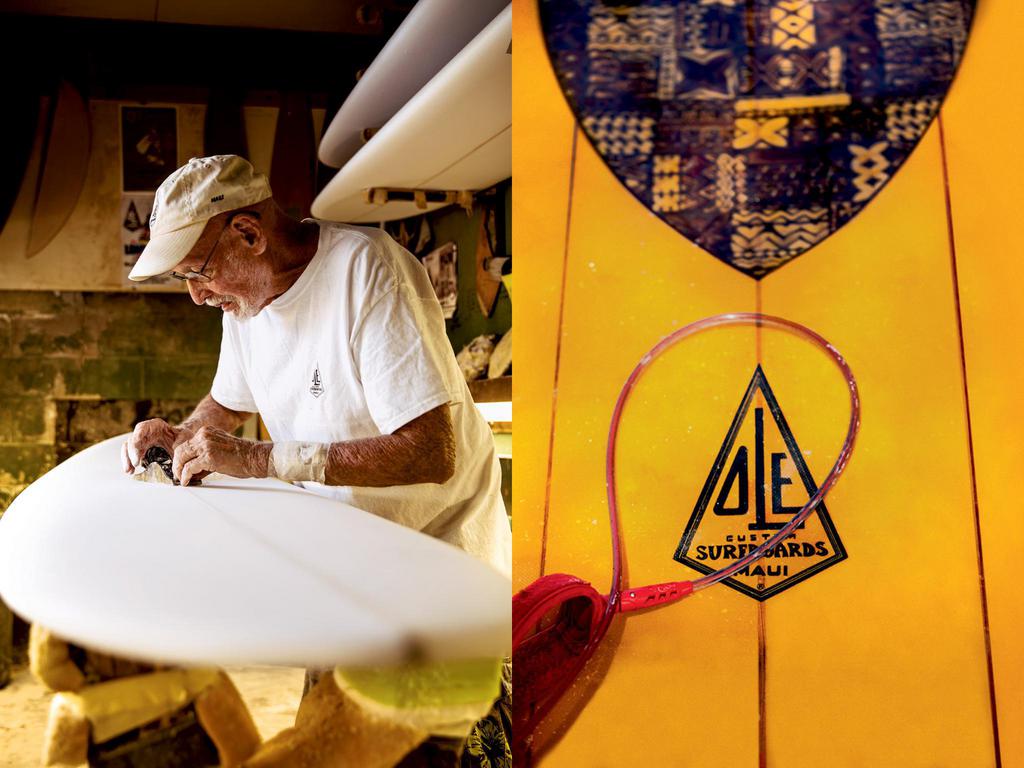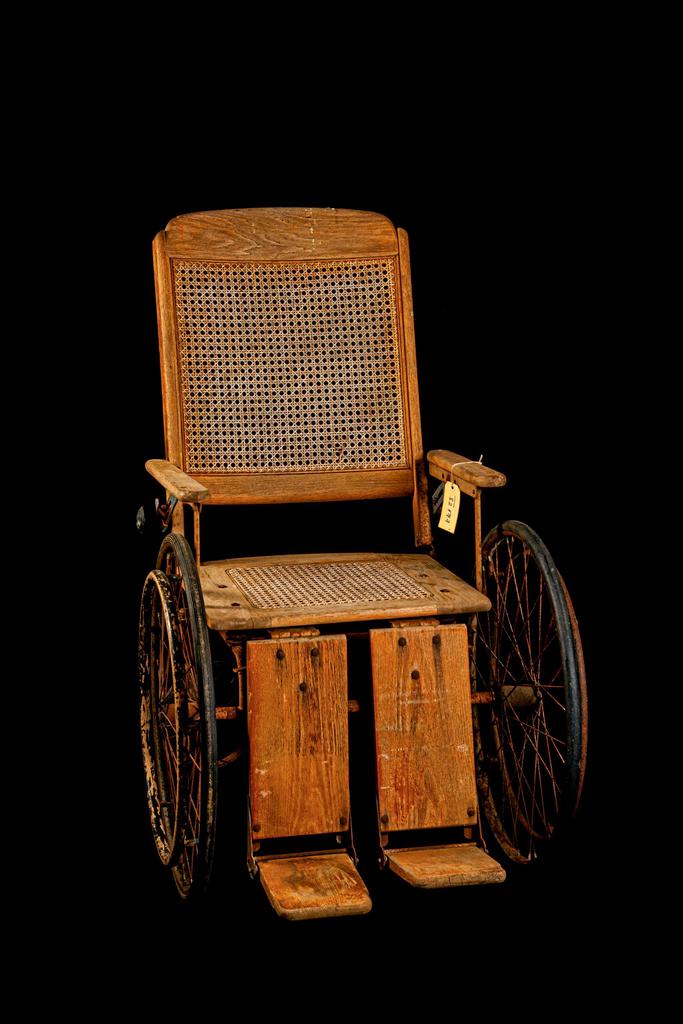When I meet Solo in a Honolulu garden, he seems like a typical yellow Labrador retriever—lanky, instantly friendly and lovable. But his owner, Kyoko Johnson, is all business: She’s about to demonstrate Solo’s sniffing skills. While the dog waits in the back of her pickup truck, Johnson hides a few leaves of a plant called devil weed throughout the garden, behind rocks and tree trunks spread across an area the size of a big backyard.
Chromolaena odorata—aka devil weed, devil’s snare or jimson weed—is a recent arrival in Hawai‘i, an aggressive and toxic plant that grows in thickets and threatens O‘ahu’s already stressed native forests. The pest gets its name because of the three prominent ribs on each leaf, which look like a devil’s pitchfork. Johnson offers me a leaf; she says it smells like turpentine, but to me it smells like a leaf. Solo has spent hours training on this scent I am blind to. It’s one of scores of odors he’s been taught to detect and report back to Johnson where he sniffs them.
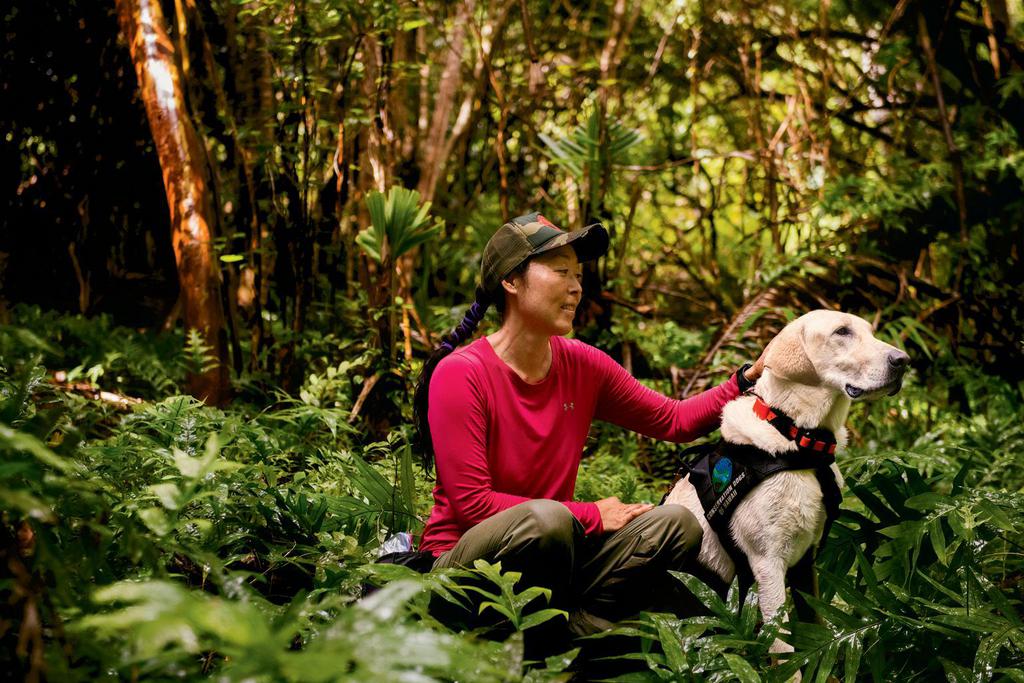
Johnson snaps a twelve-foot leash onto Solo’s harness, and he jumps out of the truck. The big, white-blond dog wags his tail: The harness, leash and Johnson’s brisk manner tell him he’s now working. Purposefully he wanders about, leading Johnson this way and that, the leash slack. Then, suddenly, his head jerks and his mouth closes as his nose goes to work, sniffing for more of the familiar scent he’s just found in the warm and barely moving morning air. In scent detection parlance, each scent source creates its own cone-shaped zone of detection, its orientation and size dependent on air conditions—warm, moist air is the best. Solo’s sniffing quickens when he finds the cone. In short order, with a series of decisive directional adjustments, he steers toward a garden boulder, sniffs behind it for confirmation and robotically sits, bright amber eyes looking up for approval—and a treat—from Johnson, who says, “Good boy!” and hands him a piece of ham. “I try to use super-high-value rewards,” she tells me, “so even if we’re out in the field and doing a long search and he’s tired, he’ll still be motivated.” Needless to say, Solo quickly and easily locates all four handfuls of the noxious weed.
As one of Hawai‘i’s very few scent detection canine teams working in the conservation field, Johnson, 47, and her dog(s) are based on O‘ahu’s North Shore and do business as the nonprofit Conservation Dogs of Hawai‘i. Recent tasks in the field include sniffing out devil weed in the forests of Hau‘ula and Paumalu on O‘ahu and reporting findings back to the O‘ahu Invasive Species Committee, a collaboration of state, federal and private agencies. Another scent detection exercise recently took place during trips to Kaua‘i to help conservation biologists at the Hanalei National Wildlife Refuge combat a lethal outbreak of avian botulism among native duck and other bird populations in the lush wetlands of the refuge. Quick detection and removal of diseased bird carcasses can slow the dispersal of the contagion, Johnson explains. The team is now looking into future trips to Midway Atoll and other wildlife sanctuaries in the state to assist in avian botulism surveys. Late last year, the US Fish and Wildlife Service awarded Johnson a contract to travel to Johnston Atoll with Solo and a Dutch shepherd named Lea to locate nests of “YCAs,” or yellow crazy ants, which can kill fledgling seabirds. The search will be handled through her for-profit LLC, Country Canine. Another project Johnson is exploring for feasibility involves rodent eradication in the Northwestern Hawaiian Islands. Other groups, she says, are considering using detection-dog teams to locate the tree fungus known as Rapid ‘Ōhi‘a Death—which is causing exactly that in the native forests of Hawai‘i Island and elsewhere—and to find the rosy wolfsnail, an invasive, cannibalistic snail that feeds on Hawai‘i’s native tree snails.
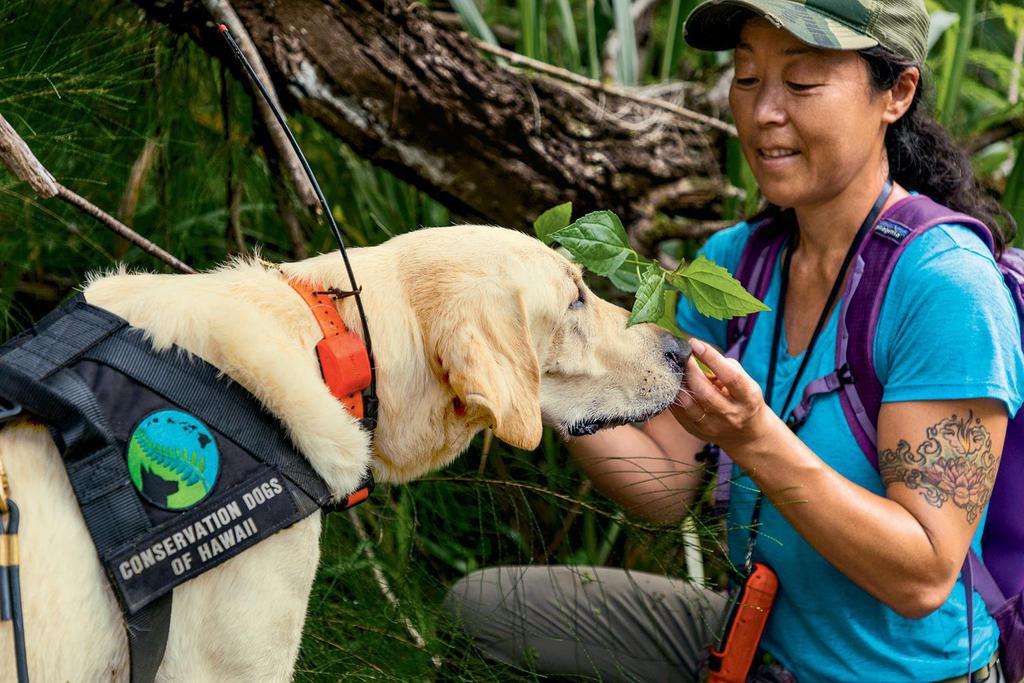
“A lot of this work hasn’t been done before,” Johnson cautions. “Whereas bomb and drug detection is now pretty common and a lot is known about how it works, with conservation work every location is different, every target species is different and it all has to be tested out. The beauty of having our nonprofit is that we’re not always bound to contracted projects. We can explore the use of dogs for various applications, test them out and see what’s feasible and doable.”
Johnson, a deliberate and thoughtful longtime surfer who loves her dogs, was born and raised in Japan but ended up in Hawai‘i after her family bought what was supposed to be a vacation house on the North Shore. Johnson took up surfing at Montauk on Long Island while studying at the Parsons School of Design in New York. After Parsons, she worked in tech marketing and eventually found herself operating remotely from her family’s Waialua beach house. For pets she acquired two unruly golden retrievers, one of which dragged her mother to the ground and broke her glasses. Johnson decided she needed to train them, and “really got into it,” she says. “One of the golden retrievers, Lucca, was not a typical golden—he didn’t like to fetch balls, didn’t want to play with other dogs, so I needed to find something for him to do.” That’s when she discovered K9 Nose Work, about nine years ago. “It’s like a dog sport,” she explains, “developed by some professional dog trainers who worked in the bomb and drug detection fields. They thought pet dogs could have some fun doing it, so they adjusted the parameters a little bit by making it more of a game for dog and owner. Now there are competitions all over the world.” Johnson, with an admittedly rigorous frame of mind, attended canine training conferences, taught classes and hosted detection canine seminars. When I comment on her scientific bent, she replies, “I work with scientists and biologists who want to have real data and not just, you know … guesswork.” Eventually, Johnson quit her day job and now makes her income training dogs and teaching other dog owners how to sharpen their own dogs’ scent detection skills.
According to scientist Brent A. Craven, a dog packs upward of two hundred million sensory neurons into its olfactory epithelium, or the membrane that covers the complex, scroll-like convolutions of the olfactory recess located deep in the dog’s head, behind the nose itself and its respiratory chamber. That smelling power—or olfactory acuity—is able to detect odorant concentration levels at one to two parts per trillion, or ten thousand to a hundred thousand times more sensitive than a human nose. In a 2009 study, Craven measured the fluid dynamics of canine olfaction. He concluded that the mechanics and patterns of sniffing—in and out, high-velocity and low-velocity—efficiently distribute odors to the olfactory recess and that dogs’ nostrils work in stereo, that is, they’re are able to compare separate inputs from each nostril to cross-tabulate an odor’s intensity and pinpoint its source.
Six commodious wire-cage kennels take up prime space both indoors and outdoors at Johnson’s vintage, salty beach house. She and husband Tor Johnson, a photographer and sailor, have two other dogs besides Solo that are themselves in various stages of training: Lea and Lea’s indeterminate love-child son Guinness, now fifteen months. Solo is the sweetest, if not the smartest of the three, Johnson says when asked. “He makes me laugh every day.”
With Solo listening attentively nearby, Johnson tells me the dog’s story, which begins in California, where a search-and-rescue dog trainer raised and trained him. The trainer supplied three of her dogs, including Solo, to a wind energy company for deployment at its thirty-turbine wind farm above the town of Hale‘iwa, on O‘ahu. The dogs’ job: to find birds and bats killed or injured by the whirring blades of the turbines. Through her work as a dog trainer, Johnson met the wind farm biologist running the program. Eventually Johnson adopted Solo and brought him home. “My husband thought I was crazy,” Johnson remembers. “When Solo, who’d always lived in a kennel, was first in the house, he just ran around in circles. He didn’t know what he was supposed to do.” Solo interrupts Johnson’s story with a sudden bark, triggered by I’m not sure what. Johnson instantly responds, saying, “Thank you, Solo,” in a casual voice, as though it’s something she reflexively does whenever the dog barks.
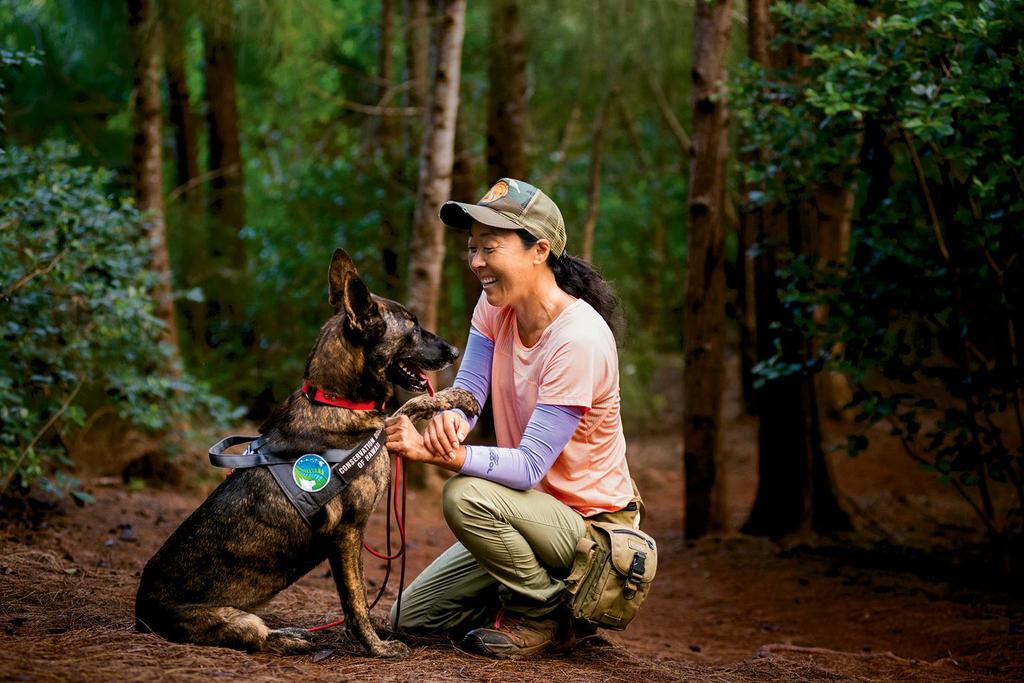
She tells me that in the detection canine world there are two especially desirable traits for working dogs: “high drive” and “nerve strength.” High drive means they have a lot of desire to hunt and perform and find a target. “They’re not going to give up just because they’re tired,” Johnson says. “My Dutch shepherd, Lea—if I throw a ball into a dense stand of tall grass, she’ll jump right in to find it, no hesitation.”
Nerve strength, according to Johnson, means a dog is not worried about hurting itself. “They’re not timid. That dog wants the ball so bad, she’ll jump off a cliff or into six-foot grass to find it.” Johnson adds that “prey drive” is another trait, but one more useful in law enforcement work than in conservation.
Johnson’s home is loaded with surfboards and dog books: The Intelligence of Dogs, A Dog’s Journey, The Detection Dog: Understanding Olfaction and Odors, Dogs Are from Neptune, One Nation Under Dog, K-9 Cop Magazine, K9 Nose Work Instructor’s Manual, among others. There’s a basket of beat-up rubber “kongs” on the big table in the main room. Stuff the hollow toys with kibble and dogs will be busy for minutes if not hours, trying to knock or lick food out through the small openings. The idea is to make them work for their food, Johnson says. “It’s called an enrichment toy.”
I glance at Solo’s noble muzzle and admire Lea’s diamond eyes and sleek, dark police-dog looks. Among all the slobbery, lovable, ball-crazy dogs I’ve known, these two self-possessed animals are actual operatives, foot-soldier heroes mobilized in defense of Hawai‘i’s native biota. How do they think? What do they know? What do they see when they’re sniffing? Is it all governed strictly by instinct and ham treats, or do they picture something else as they work? And how enriched can they get?
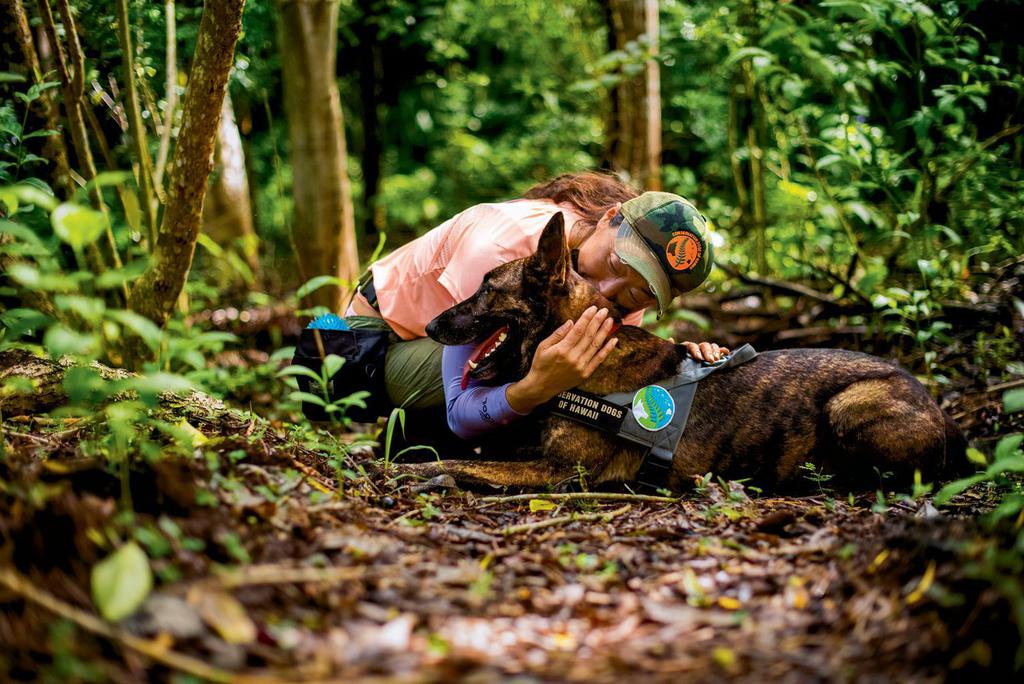
These questions float around in my head as Johnson frees Guinness from his outdoor kennel so all five of us—two humans, three dogs—can walk the sandy path through the naupaka scrub to the beach. The athletic and well-behaved dogs, goaded by Guinness, finally cut loose and play a strenuous game of tug-of-war with an orange kong on a blue polypropylene rope tether, bounding, splashing and knocking each other about in the gentle shore break.
Watching the dogs be dogs, I realize it’s possible to overthink them. “Dogs really do have a great sense of smell,” Johnson had insisted when we first met, “but in our world they don’t really get to use it much. We’re always telling them to stop smelling people’s crotches and yanking them away from stuff and telling them ‘Sit!’ and ‘Stay!’ instead. But dogs just love sniffing. It’s what they do best, it’s how they perceive the world. The shy ones gain confidence, the crazy ones calm down. It’s great activity for the dog.” HH
